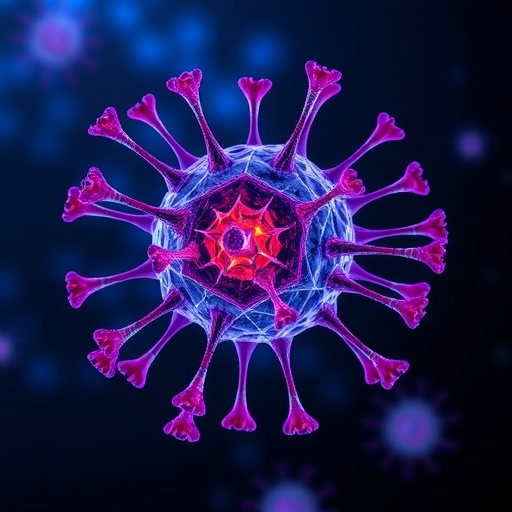In the rapidly evolving landscape of cancer immunotherapy, recent groundbreaking research delves into an underexplored yet pivotal component of the immune system: natural killer (NK) cells. These lymphocytes serve as critical first responders in the body’s defense against malignancies, endowed with the capability to detect and eradicate tumor cells without prior sensitization. However, tumors have evolved sophisticated mechanisms to circumvent NK cell-mediated cytotoxicity, chiefly through the subversion of immune checkpoints—molecular regulators that temper immune responses to maintain self-tolerance and prevent autoimmunity. The latest comprehensive review in Reserch elucidates how cancer cells exploit these inhibitory pathways on NK cells to impair anti-tumor activity, unmasking new avenues for therapeutic intervention.
Fundamentally, NK cells balance signals from activating and inhibitory receptors to determine whether to initiate an attack on a target cell. Tumor cells manipulate this balance by engaging inhibitory receptors such as TIGIT (T cell immunoreceptor with Ig and ITIM domains), PD-1 (programmed cell death protein 1), and NKG2A, effectively silencing NK cell functions. These “checkpoints” downregulate cytotoxic granule release, suppress pro-inflammatory cytokine production, and halt NK cell proliferation, allowing malignant cells to thrive undetected. Moreover, intracellular molecular players like BIM, a pro-apoptotic Bcl-2 family member, and EZH2, an epigenetic modulator, further contribute to NK cell exhaustion by promoting apoptotic pathways and transcriptional repression within these immune effectors.
The therapeutic implications of reversing NK cell inhibition are profound. Clinical trials employing anti-TIGIT monoclonal antibodies (notably tiragolumab and vibostolimab) in conjunction with PD-1 inhibitors have demonstrated a remarkable doubling of progression-free survival among patients with hepatocellular carcinoma. This dual blockade effectively restores NK cell cytotoxicity by preventing tumor ligands from engaging inhibitory receptors, thereby reigniting the immune assault. Beyond antibody therapies, novel genetic engineering techniques such as CRISPR-Cas9 have been utilized to knock out genes encoding inhibitory receptors like NKG2A in NK cells, resulting in an 80% enhancement in their capacity to kill tumor cells in vitro and in preclinical models.
Pioneering advances in chimeric antigen receptor (CAR) technology expand NK cell utility by reprogramming these cells with surface receptors that recognize specific tumor antigens. For instance, CAR-NK cells engineered to target TIM-3 or NKG2D ligands have shown powerful efficacy against acute myeloid leukemia (AML) cells. Remarkably, unlike CAR-T cells, CAR-NK therapies confer a reduced risk of graft-versus-host disease (GVHD), making them safer candidates for “off-the-shelf” therapies. This innovation opens a new frontier for adoptive cell transfer therapies with enhanced specificity and minimal toxicity.
The clinical urgency of restoring NK cell activity stems from mounting evidence correlating NK cell dysfunction with poor prognostic outcomes across hepatocellular carcinoma, non-small cell lung cancer, and colorectal cancer. Tumor-induced NK cell suppression fosters immunologically “cold” tumor microenvironments characterized by low immune infiltration and scarce inflammatory cytokines. Checkpoint blockade strategies reprogram these “cold” tumors into “hot” tumors teeming with immune effector cells, thus enhancing responses to immunotherapy and potentially overcoming resistance seen with T-cell-targeted therapies.
The mechanistic insight into checkpoint modulation highlights how TIGIT competes with activating receptor DNAM-1 for binding to the ligand CD155 on tumor cells, tipping the balance toward immune suppression. Similarly, PD-1 engagement triggers inhibitory signaling cascades that undermine NK cell metabolism and signaling pathways critical for effector functions. NKG2A binds to HLA-E molecules presented on tumor cells, delivering inhibitory signals that blunt NK cell activation. These intricately orchestrated interactions underscore the multi-layered complexity of NK cell regulation in the tumor milieu.
The intracellular axis involving the pro-apoptotic protein BIM further complicates the NK cell response. BIM promotes apoptotic signaling when upregulated, a state seen in tumor-infiltrating NK cells subjected to chronic stimulation and exhaustion. Epigenetic regulation by EZH2 represses transcription of genes vital for NK cell activation and survival, thereby sustaining a hypofunctional phenotype. Targeting these intracellular checkpoints may offer combinatorial strategies to rejuvenate exhausted NK cells alongside surface receptor blockade.
Current clinical interventions targeting immune checkpoints, such as PD-1, have primarily focused on T lymphocytes. However, this emerging paradigm emphasizes NK cells not only as complementary effectors but also as independent targets for immunotherapy. NK cells possess innate advantages, including the recognition of stressed cells in the absence of antigen processing, providing a rapid immune response that does not depend on prior sensitization or peptide presentation by MHC molecules. These features suggest that NK cell-based therapies might circumvent some limitations observed with T-cell-centric treatments.
Dr. Peng Luo, co-corresponding author of the study, articulates the transformative potential of NK checkpoint targeting: “Unlike T-cell therapies, NK-based strategies offer ‘off-the-shelf’ potential with fewer side effects.” This ease of manufacturing and administration could democratize access to effective cancer immunotherapies, reducing costs and expanding treatment options for diverse patient populations.
Furthermore, the combinatorial approaches that harness multiple checkpoint inhibitors alongside gene-edited NK cells establish a flexible therapeutic platform adaptable to various cancer types. Investigations into optimizing CAR constructs specific to NK cell biology continue to refine efficacy and persistence in vivo. Coupled with efforts to modulate the tumor microenvironment—such as reducing suppressive cytokines and enhancing NK cell homing—these innovations herald a new generation of immunotherapies.
Looking ahead, integrating biomarkers that accurately gauge NK cell exhaustion and functional status could tailor immunotherapeutic regimens, maximizing efficacy while minimizing adverse events. The synergy between checkpoint blockade and metabolic reprogramming of NK cells is an exciting frontier, with metabolic fitness proving crucial for sustained anti-tumor responses.
In essence, unveiling the sophisticated network of checkpoints governing NK cell activity reshapes our understanding of immune surveillance in cancer. By targeting these brakes, scientists are not only offering hope for improved clinical outcomes but also forging a new path for durable and broad-spectrum immunotherapies. This body of work signals a paradigm shift, positioning NK cells at the vanguard of next-generation cancer treatment modalities.
Subject of Research: Not applicable
Article Title: NK Cell Immune Checkpoints and Their Therapeutic Targeting in Cancer Treatment
News Publication Date: 3-Jun-2025
Web References: http://dx.doi.org/10.34133/research.0723
References: http://dx.doi.org/10.34133/research.0723
Image Credits: Anqi Lin, Pengxi Ye, Zhengrui Li, Aimin Jiang, Zaoqu Liu, Quan Cheng, Jian Zhang, and Peng Luo
Keywords: Cancer




